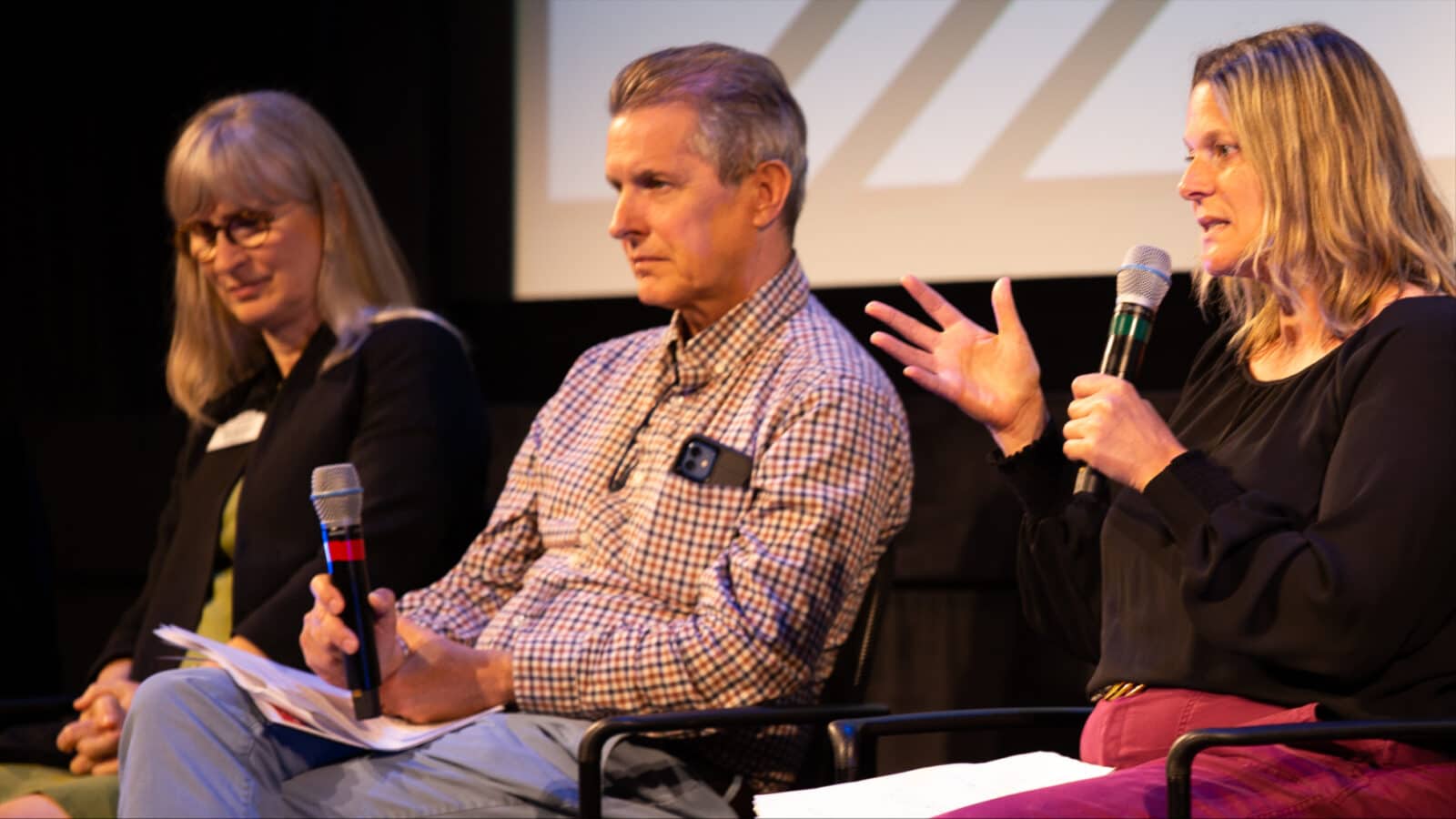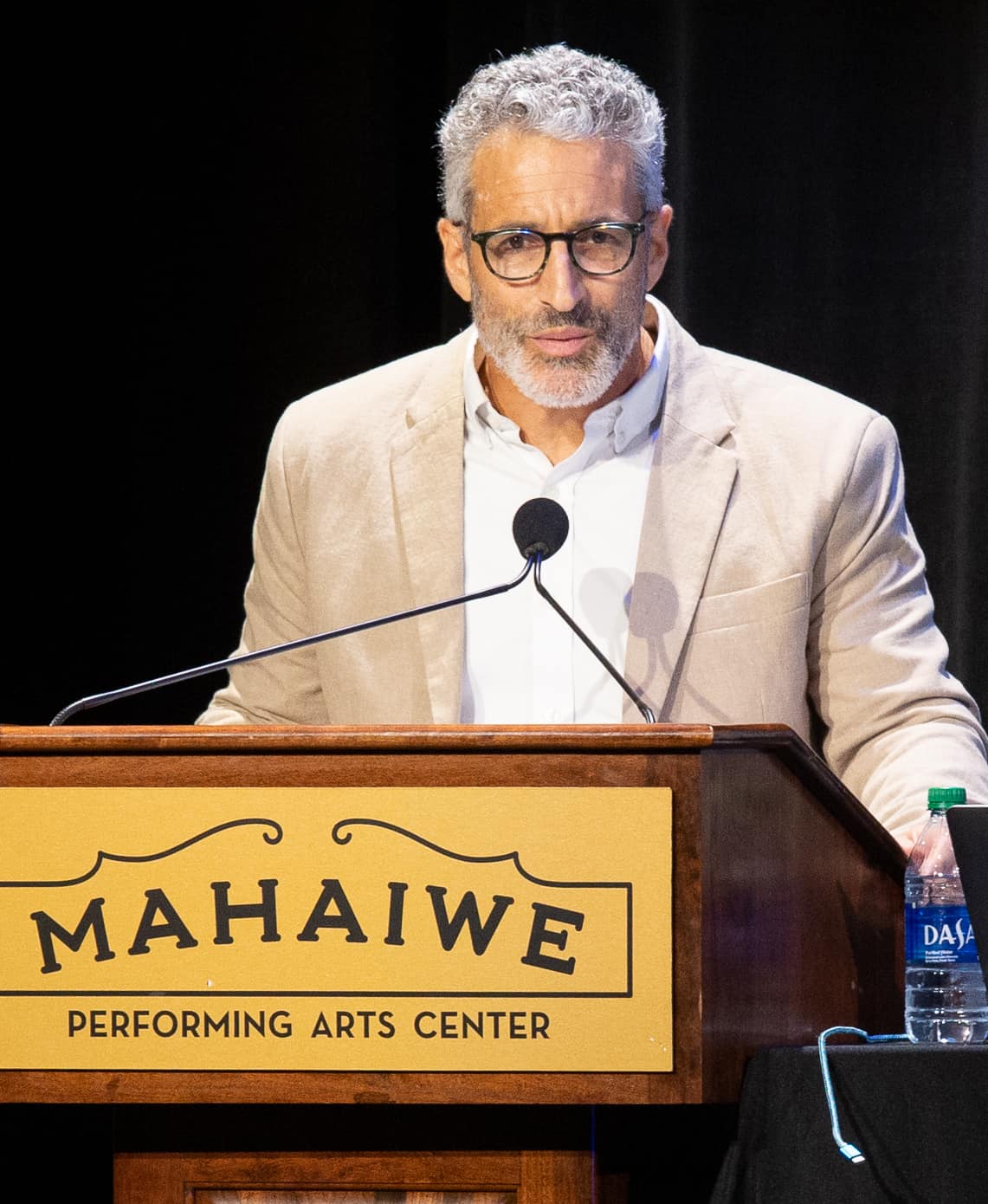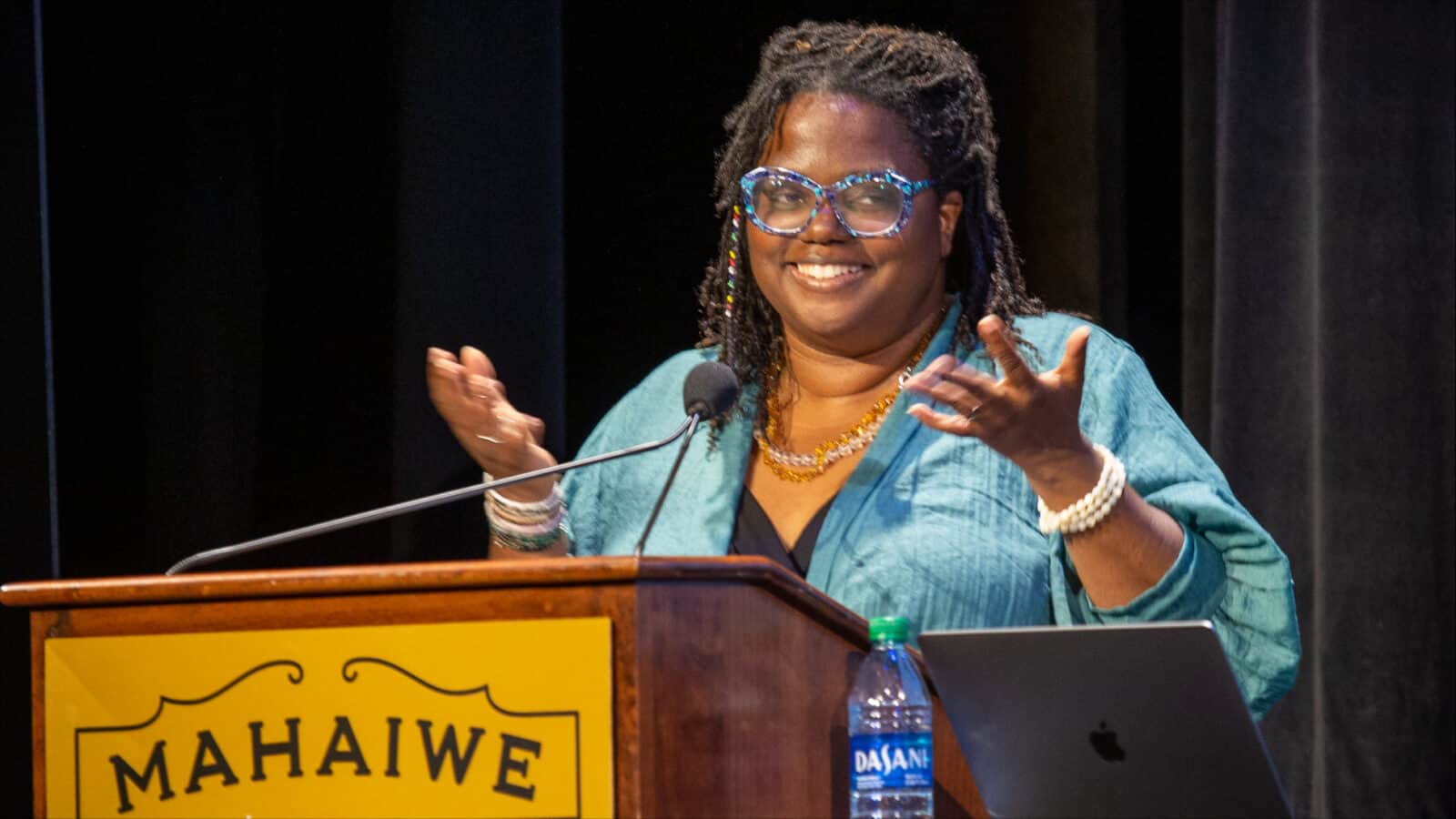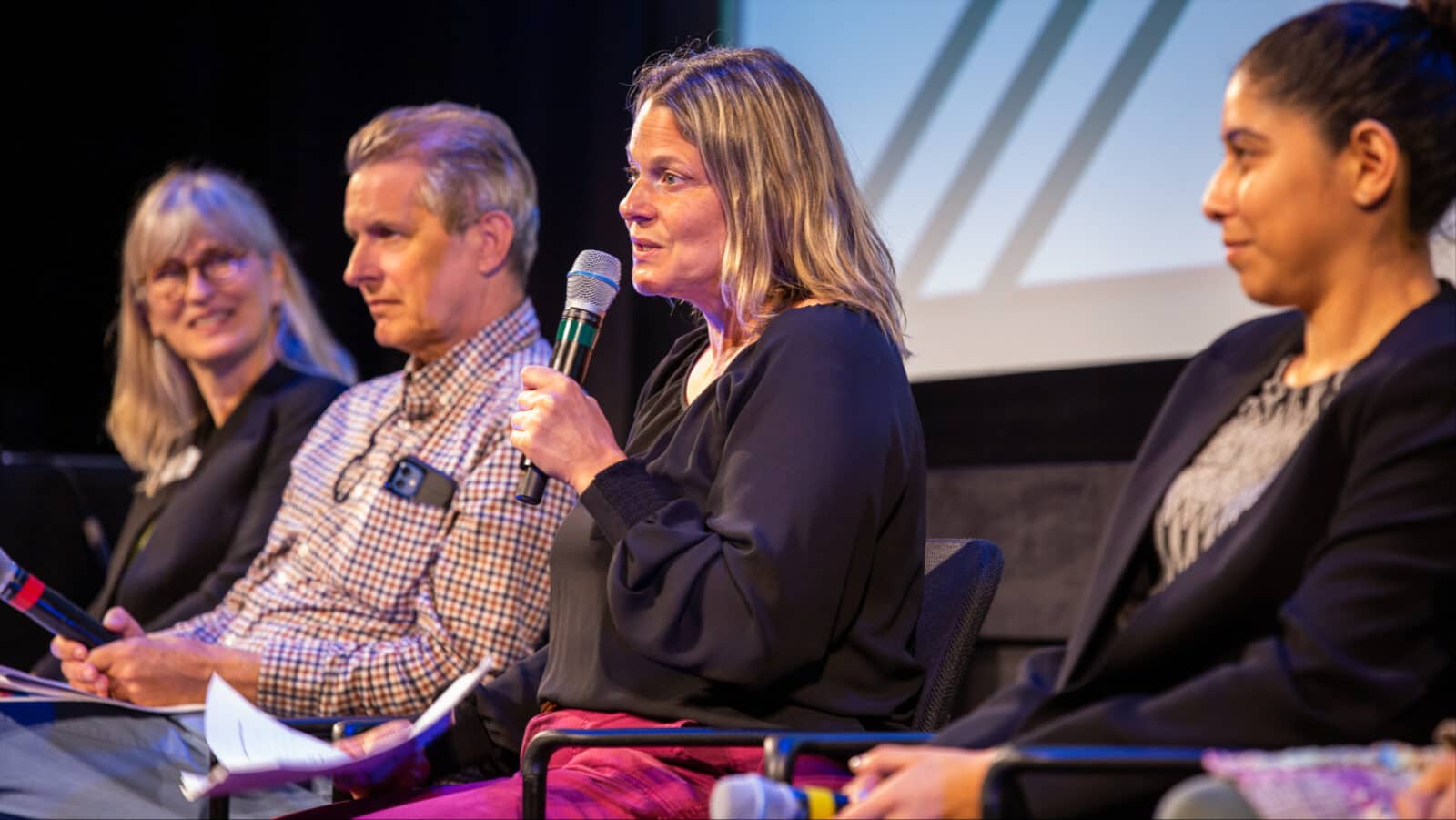Guitars strum and fireflies gleam in the meadow. Actors are falling in love every night, and stages large and small are alive with dance and music. It’s summer in the Berkshires.
But behind these scenes that define the region’s image as a hub of culture, many of the people who keep the local creative economy humming are struggling.
Entry- and mid-level workers in the arts are logging long hours for low pay, and some who have long experience in the local arts scene are leaving for new places or new careers, deciding they can no longer afford this line of work.
Over the past year or so, a group of arts organizations in Berkshire and Columbia counties has begun working to change this movement. Their leaders have been talking with the people who make the shows and exhibits happen.

Aron Goldman speaks at the Pay Equity Project's presentation in June 2023 at the Mahaiwe Performing Arts Center. Press photo courtesy of WAM and the Mahaiwe
And as they look to the future, these leaders are recognizing larger systematic challenges in the field. They’re exploring the need for diversity, equity, fair pay – and for understanding the experiences of their workers and investing in their futures.
In June, a coalition of eight arts groups on both sides of the state line announced the findings of the Berkshire/Columbia Counties Pay Equity Project, a yearlong effort in which they surveyed about 200 entry- and mid-level employees at 43 local arts and cultural organizations. The project also collected anonymized data on pay and benefits from 38 arts employers with nearly 1,000 workers in the region.
The study concluded that local arts and culture workers are “undercompensated, struggling to meet basic needs, and considering imminent moves” out of the area – or out of arts-related professions.
“Many of us are working in organizations small enough that we’ve witnessed on a day-to-day basis the struggles that our employees are having,” said Janis Martinson, executive director of the Mahaiwe Performing Arts Center in Great Barrington, in an interview over Zoom with Kristen van Ginhoven, executive director of WAM Theatre in Lenox, and Aron Goldman, a consultant who guided the project.
Figuring out how to improve pay and working conditions in the arts, they contend, will strengthen creative nonprofits and the diversity of their staffs, the beauty and power of their work, and the local economy as a whole.

Kristen Van Ginhoven speaks as Janis Martinson listens at the Pay Equity Project's presentation in June 2023 at the Mahaiwe Performing Arts Center. Press photo courtesy of WAM and the Mahaiwe
After crises, rethinking the arts
This is a vulnerable time for the region’s creative places. Arts and cultural organizations are trying to rebuild after three years of lockdown and upheaval. In the wake of the pandemic and a global racial reckoning, equity movements in the arts have emerged across the country in theater and dance and other sectors.
Through social-media-based efforts such as Change the Museum and We See You White American Theater, people working inside arts organizations have highlighted cases of racial bias, pay disparity and other inequities. Local conversations like Change Berkshire Culture have brought these questions home.
Some see this moment as an opportunity for real change.
“I feel a certain sense of urgency,” Goldman said. “We don’t know how long we’re going to have people’s attention for transformative change. So now is the time.”
‘I feel a certain sense of urgency. We don’t know how long we’re going to have people’s attention for transformative change. So now is the time.’ — Aron Goldman, consultant
Martinson said the local pay equity project began with arts leaders who took part in a yearlong inclusive leadership program organized by the local nonprofit Multicultural BRIDGE.
As the program sparked conversations, more oragnizations joined in — the Pay Equity Project now includes the Mahaiwe and WAM, Art Omi, Berkshire Art Center, Community Access to the Arts, Flying Cloud Institute, Jacob’s Pillow Dance Theater and the Williamstown Theatre Festival. (The Berkshire Taconic Community Foundation has provided funding to support their work.)
From the data and survey responses the study collected from local arts and cultural workers and their employers, the coalition found that:

Aron Goldman speaks at the Pay Equity Project's presentation in June 2023 at the Mahaiwe Performing Arts Center. Press photo courtesy of WAM and the Mahaiwe
Experiences in the field
• 56 percent of employees said they needed to work additional jobs to support themselves.
• Some 30 percent of local arts workers are full-time employees earning less than $50,000 annually — many of them far less than that — and another 25 percent are part-timers with hourly wages of less than a $50,000 full-time annual equivalent.
• Their average hourly wage of $19.49 barely exceeds the livable wage rate for the region.
• 75 percent reported working unpaid overtime.
• Between 25 percent and 48 percent lack benefits such as health insurance, retirement plans or paid time off.
The emotional responses of arts workers who took part in the survey came across to Martinson very vividly.
People love working in the arts, she said. They want to do this work. They respect the creative places and the people they work with and for. And they are exhausted.
One study respondent who left a position at a local arts organization told of taking a new job in a different field at slightly lower pay. (The study quotes many arts workers describing their experiences and working conditions but does not reveal their identities, to protect them.)
“But this one does not require unpaid overtime or a passionate sacrifice of my time, energy and mental health,” the person wrote.
Martinson, van Ginhoven and their colleagues say they recognize the challenge posed by average hourly wages that often are barely above a living wage — even for mid-level workers with years of experience.

Janis Martinson speaks at the Pay Equity Project's presentation in June 2023 at the Mahaiwe Performing Arts Center. Press photo courtesy of WAM and the Mahaiwe
And they say they’ve come to understand that limited resources affect equity and diversity across their organizations. Many potential job seekers are excluded from applying, because very few people can afford to work for the pay local arts groups are offering. The burden can be greater for those from communities that historically have faced higher barriers with fewer resources.
Conversations about fair compensation have a new urgency for organizations that want to attract and keep diverse work forces in terms of race, ethnicity, socioeconomic background, gender, gender identity, sexual orientation, ability and more.
“You’ve had a long history, in the decades that I’ve been in nonprofit organizations and around arts and education, of ‘do more with less’ – which means less for the people doing the work,” Martinson explained. “And we’ve hit a wall where there are so many reasons why that’s no longer defensible.”
‘Further and further behind’
Goldman said the project set out to gather detailed information by surveying arts workers and employers, following up with focus groups and some long-form interviews. Although the study report quotes a variety of arts workers describing their experiences and working conditions, their identities are not revealed.
The findings are sobering, he said.
People outside the field may have an impression that working in the arts is a privilege. Goldman said he might agree, not because people in the arts are making money — but because they make so little that very few people can afford to work such long hours for such low pay.
Many of the survey respondents described living precariously with no change in sight.
“My life isn’t sustainable,” one respondent wrote. “The cost of living for [my family] is approximately 40 percent higher than my salary. I get further and further behind in all ways: financial, social fabric, health, education.”
‘My life isn’t sustainable. The cost of living for [my family] is approximately 40 percent higher than my salary.’ — survey respondent working in the arts
“Even after more than 10 years in the sector,” another respondent said, “I have no retirement savings and am still paying off college debt.”
Another wrote: “My supervisor lowered his own salary in order to increase mine.”
Data from the study show more than half of local arts workers are paid at a full-time-equivalent rate of less than $50,000 a year, and many earn much less. Their average hourly wage of $19.49 barely exceeds the livable wage rate for the region, which the MIT living wage calculator pegs at $17.78 for a single adult.
And for anyone with children or a family, or with student loans or any other ordinary debt, Goldman said, the pay “becomes severely insufficient.”

Gwendolyn Van Sant, Founder and CEO of Bridge, welcomes the gathering at the Pay Equity Project's presentation in June 2023 at the Mahaiwe Performing Arts Center. Press photo courtesy of WAM and the Mahaiwe
When employers in the survey discussed compensation, several reported amounts barely above the minimum wage of $15 an hour in Massachusetts and $14.20 an hour in New York.
“We raised salaries to $15 an hour and are planning another increase,” one organization wrote.
“The starting wage, including our tipped employees, is $15 an hour,” another noted.
The study found that benefits for part-time workers are inconsistent, insufficient or nonexistent, and 75 percent of the workers reported they are regularly expected to work unpaid overtime adding up to 70 hours a week or more.
Wider economic effects
These patterns can have effects well beyond individual employees and arts organizations – and can ripple through downtowns.
“Arts and culture is a big part of the economy of the Berkshires and Columbia County,” Martinson said. “It’s also a very visible part of the economy.”
So if employees of local cultural organizations are struggling, that can affect the health of the organizations themselves and the health of the local economy more broadly.
“If you want our community to continue thriving, these places need to succeed,” van Ginhoven said.
The economy of the Berkshires has shifted and is shifting, they said, toward what Williams College economics professor Stephen Sheppard has called an economy of making experiences.
They are intertwined experiences, Martinson said. People who come to a museum or a play go out to local restaurants and shops, and people who visit for a hike or bike ride may also go to a concert or a farmers market. Arts and culture cross paths economically with local food and the outdoors, local businesses and entrepreneurs.
To give an overview of the local economy, the Pay Equity Project’s study includes figures from the local economic development group 1Berkshire. These figures separate out creative organizations from food and tourism, but when combined these fields total more than $1.2 billion in economic activity and become the largest economic element – bigger than health care, manufacturing or government.
Calling for a cultural shift
Beyond the numbers, a broader current emerges in the study and responses: Over and again, questions arise about how an organization values the people who work for it.
Martinson said she was struck forcibly by how much she has heard about the emotional burdens of being undercompensated.
“I do not feel valued (monetarily or otherwise) for my contributions to the organization,” one of the workers surveyed wrote.
“Even more than compensation, the workplace culture needs to change,” another said.
Not making enough to live on is exhausting in itself, many of the respondents said. But they expressed as deep a frustration, or more, in feeling that their workplaces did not seem to see, hear or invest in them. They called for ways to learn, to grow, to do their work better, to have the time and energy to be creative, and to grow relationships.
“I don’t need verbal pats on the head to affirm the importance of my work for this community,” one respondent wrote. “I need salary and advancement that adequately values my time, so that I can properly care for my family, friends, colleagues and community.”
‘I don’t need verbal pats on the head to affirm the importance of my work for this community. I need salary and advancement that adequately values my time, so that I can properly care for my family, friends, colleagues and community.’ — Survey respondent
For Goldman, as for Martinson and van Ginhoven, hearing from so many voices had an impact. He said this study is important — and rare — because they have gathered as much information as they can from a diverse group of people on the ground and directly affected.
“Paying someone so little puts them into a perpetual state of worry, unease and hopelessness,” one respondent wrote.
Another described “nights working until 2 a.m.”
“One thing that doesn’t always get considered is how much time it takes to navigate living on a lower-income / being resourceful / maintaining public benefits / participating in mutual ways in community care / working other gigs,” another wrote. “These all take time and energy, and so I feel like I’m working full time, even though I am at half time with my organization.”
Any real impact must come from a process that is equitable in itself, Goldman said, and the group can only come up with effective ideas when they engage the people who are closest to the challenges themselves.
“At every step,” he said, the project’s organizers were “thinking very conscientiously about how to reverse traditional power dynamics and make change in a holistic and durable way.”
Leading a push for change
As the study presents employees’ thoughts, some employers report specific and substantial changes designed to increase compensation equity. But nearly two-thirds of the employers who responded said they have no plans to increase pay equity or aren’t sure what steps to take.
So the organizations behind the study are offering concrete suggestions. Through this year of conversations, van Ginhoven said, she and all of the creative nonprofits involved found changes they could make now, without great effort, just by making pay equity a priority.
Showing an interest in their staff’s lives can matter, she said, quickly and tangibly — by thinking about how the board talks with staff, acting with greater transparency and flexibility, issuing paychecks on a flexible day.
“Relatively easy lifts for us may make a big difference in the lives of our staff,” she said, and Martinson agreed.
‘Relatively easy lifts for us may make a big difference in the lives of our staff.’ — Kristen Van Ginhoven, artistic director of WAM Theatre
Providing paid vacation days for part-time employees can make a difference, they said, as can settling out health-care insurance or stipends, offering a babysitter or caregiver or paying gas money when artists are driving from venue to venue to venue.
Leaders in the arts act as a bridge between their staff and their audiences, on the one hand, and their boards and funders, van Ginhoven said. It took courage, she said, for employees to share their experiences, and she wants to reinforce that their stories have not fallen on deaf ears.
She and Martinson say they want to amplify the voices of their employees and make sure people are hearing them — to raise awareness and to act together as allies.
The eight organizations behind the Pay Equity Project have been talking with their boards and funders since the project began. In the coming year, with the weight of documentation in the study, they hope to make the case to individual donors, leaders within their own organizations, and to the broader public with a united voice.
“It’s a systemic issue,” Martinson said. “It’s a national issue. It’s an arts issue.”
‘It’s a systemic issue. It’s a national issue. It’s an arts issue.’ — Janis Martinson, executive director of Mahaiwe Performing Arts Center
And it’s part of a larger story that can engender real response and empathy.
Goldman said they aim to challenge common assumptions among nonprofit organizations — for one, that they can more readily find funding for programs and performances than for people. In fact, funding already exists to support employees and operating expenses, he said, and since Covid he sees this shift intensifying.
Investing in people also can help creative nonprofits to grow over time. Those that give resources to “technology, equipment, staff training, program development and fund raising” are often more successful, the study says, citing the Chronicle of Philanthropy and a recent in-depth study of more than 4,000 nonprofits across 10 years.
“We need trust-based philanthropy, capacity-building philanthropy,” van Ginhoven said, “understanding that we need to spend less time applying for grants and reporting on grants and less time building programs that fit the grants and more time … delivering on our mission and taking care of our teams and our artists and our cultural workers.”
Goldman speaks with respect of the local employers that have supported the Pay Equity Project, and he says they want to be champions for their staffs.
“I got so much robust team work and partnership from every single member of this group,” he said, adding that as a consultant, he has not always found that kind of energy. He said is optimistic for the future of the region’s creative organizations and their employees.
“My experience consistently is,” he said, “that once you present the facts and the stories to decision makers, they are often motivated to make change.”

